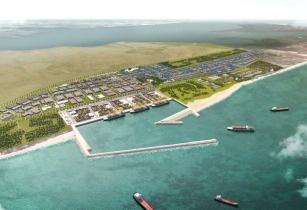
The MR 418 A was then added to the outside of the westernmost cell. (Image source: Manitowoc)
The Potain MR 415 and MR 418 A tower cranes are quietly growing along with the building — and also inside it
Forming part of the western parcel of the 4.8-acre Bulfinch Crossing mixed-use development, a stone’s throw from Boston City Hall, the imposing new building tops out at around 565 ft and offers spectacular views over the city and harbor. The innovative approach to its construction was a result of the desire to begin leasing space within the tower as quickly as possible, explained Cori Amadon, vice-president at James F Stearns, the leading crane provider for the project.
Core skills
Using Potain MR cranes on the project was an inspired choice. The interchangeability of their bases with those of its sister ranges, the MD and MDT models, increased the number of installation options for internal and external climbing configurations.
Demolition of an adjoining car park exposed a row of four connected concrete core cells that provided fully enclosed support for the climbing mechanism for the Potain MR 415. The MR 418 A was then added to the outside of the westernmost cell, where it too would soon be largely obscured from view by the steel frame of the tower being built around it.
In collaboration with engineering firm Howard I. Shapiro & Associates, plans were drawn up for each stage of the MR 415’s upward journey. For Phase 1, the initial installation, the crane would be freestanding, with just under 197 ft of mast, and a similar jib length.
The contractor’s desire for a spacious working platform had left a gap of mere inches around the mast perimeter and the core walls, leaving the riggers with no opportunity to assemble or drop in the mast from above. Instead, the beams were pulled into the bottom of the core through a doorway, assembled at ground level, and then maneuvered into position by crane and/or air tuggers.
The crane climbed another 90 ft during each of the next two stages, with a second diving board added at level 32 during Phase 4 and a third board seven floors later during Phase 5, by which time the structure had reached level 42. For the final push, Phase 6, one last climb of 88 ft would be sufficient to enable topping off in July 2021, with the crane supported by the diving boards on levels 32 and 39.
“One of the unique things about this project is that it has a four-cell system from ground level up to level 25, and then one of the cells ‘disappears’ and it turns into a three-cell core,” Amadon explained. “So, initially we were working internally surrounded by a concrete cell up to level 25, but then we had to come out of that and switch from a four-sided support system to utilising a diving board system on the outside of the core.”
The crane climbed another 90 ft during each of the next two stages, with a second diving board added at level 32 during Phase 4 and a third board seven floors later during Phase 5, by which time the structure had reached level 42. For the final push, Phase 6, one last climb of 88 ft would be sufficient to enable topping off in July 2021, with the crane supported by the diving boards on levels 32 and 39.
“One of the unique things about this project is that it has a four-cell system from ground level up to level 25, and then one of the cells ‘disappears’ and it turns into a three-cell core,” Amadon explained. “So, initially we were working internally surrounded by a concrete cell up to level 25, but then we had to come out of that and switch from a four-sided support system to utilising a diving board system on the outside of the core.”
More options with Potain
These smaller, lighter cranes provided further benefits to a project that might once have relied on the use of larger, more costly models.
“By reducing the loads that are imposed, they give you the flexibility to come up with a different type of support system that’s not as cumbersome as would be needed to support a larger tower crane,” Amadon explained. “You can get great results working with an MR 608 (32 t maximum capacity) from the perimeter, but if you put a 24-ton capacity MR 418 into the core of a building with a shorter boom, you can pretty much get the same benefit.”

























